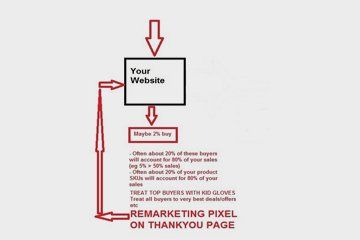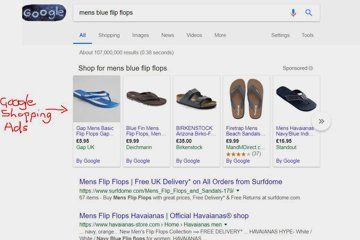Extensive knowledge
PPC Advertising
We use PPC to target our best customers through remarketing. Next we target people who have considered buying from us. Then we find lookalikes of these groups.
Google Search Advertising
Within Google Search Advertising there are 2 major types
1. Search Campaigns
We initially suggest concentrating on a specific type called Remarketing Lists For Search Advertising Campaigns (RLSA) which are driven by keyword searches by specific types of people who are in our Audience lists
Let’s say your website conversion is 2% then 98% of people coming to website don’t buy.

Just 2% Do buy. So, firstly we concentrate on them - they are our Bullseye Buyers. We need to get them back to the site to buy more and/or more frequently.

Existing Buyers - 2%
• We target the 2% of visitors to our website who are buyers and separate them out as an individual audience using Google Ads (including youtube). These are our Bullseye buyers – we get back in front of them using Remarketing. This uses a little piece of code on your site to identify their actions on your website (so we can follow them round the web). If we have sufficient numbers of buyers we could even select top buyers (On a Recency, Frequency or Value Basis) and separate these out. There is a good chance that 20% of these people may well lead to 80% of sales. We then develop strategies for our promotions/ads to get them to buy more and/or more often.
• We can also Target our email list for advertising on both Facebook and to a lesser extent Google (upload the list - or section of the list – HINT BUYERS
- and they will match the email addresses). Don’t worry you’re not handing over your data - it is encrypted. This is another way of getting in front of our “bullseye” buyers
“Close to” Buyers
• Of the 98% who don’t buy, some of our website visitors will exhibit some behaviour onsite that will be an indicator that they have considered buying. (Visited shopping basket, visited product spec pages, downloaded product brochure, high time on site etc etc). Again, we can create audiences of these people for advertising on both Facebook and Google and Remarket to them. Reminding them of the products they thought of buying. We can develop strategies to get them to move from considerers to buyers.
We can also be far more effective by just simply excluding people who have visited the site and just bounced away (often a significant proportion).
Lookalikes/Similar to Existing Buyers or Lookalikes of "Close to" Buyers
• We can find people who are similar to our buyers audience, our “close to” audiences plus our email list on both Facebook and Google

2. Shopping Campaigns
These are the second type of Google Search Ads and are (driven by a feed of your products uploaded to google). If you sell online these can be extremely profitable.
Plus you can be extremely product (SKU) focused and also keyword focused. Yes 80/20 happens with both products and keywords. There is often poor (and/or very expensive) service from Big Agencies for Google Shopping Ads. We specialise in it
eg. Google Shopping profitability £55k revenue from £2.2k spend Return On Ad Spend ROAS 2494%
Google
Display Network Advertising
Google Display Network Advertising
is the other (much less well-known side) of Google Ads. It is a collection of 2 million websites which have agreed to show Google Ads on their sites. Sites like YouTube, Dailymail.co.uk, independent.co.uk etc etc.

Existing Buyers + "Close to" Existing Buyers through Remarketing
We can advertise using Google Display Network (including YouTube) and Google Analytics to guide Audience selection and, of course, use our remarketing audience lists to further refine campaigns
By delving into Google Analytics we can make our Website Custom Audiences even smarter (new v repeat visitor, source media/length of time on site/number of pages viewed etc etc). Basically, however you can slice and dice Google Analytics you can do with individual Custom Audiences (and then of course find lookalikes)
If we have sufficient budget we can also advertise using different Topics
Google has 2,221 topics currently available, and it categorizes every page into one or more topics. (Most pages generally have more than one topic.)
We can also advertise using InMarket
targeting
In-market targeting is based on people’s recent behaviour in the past one to two weeks. Google knows if your search and browsing habits match people who are just about to buy and we can identify people who are “in the market” for a particular product or service based on the content of the sites and pages they visit and recency and frequency of the visits. Google has 390 in-market categories. This is particularly valuable for non-frequent purchases and using this as an Audience to upbid to those Google knows is "In The Market" to buy
And we can also advertise using Affinities
Google has 88 affinity categories - people based on their long-term search history to target people who have demonstrated a longstanding interest in something (Rock Music Fans, 30 Minute Chefs, Art & Theater Aficionados etc etc)
We can then overlay keywords and/or demographics to make targeting for Topics, In Market or Affinities even more precise
Our Google Ads strategy ensures that we use the multitude of clever ways to target our best potential customers first and then (if budgets allow to move out to people who have nearly bought and then to people who look similar to our existing buyers. Each of these methods are extremely cost effective.
There are one off fees for setting up the Pay Per Click Advertising but these are dependent on your specific needs. The cost for the clicks themselves are on top of this plus there is also a monthly management fee.
We also provide this service to Web Designers or Advertising agencies who want to offer their own clients Pay per click Ad services. Call us on 07989 077 778
or email us today. Based in North Norfolk, Web Visibility Solutions Ltd serves businesses across the UK.
Get in Touch
Contact us
Thank you for contacting us.
We will get back to you as soon as possible
We will get back to you as soon as possible
Oops, there was an error sending your query.
Please try again later
Email us
Share
Tweet
Share
Mail
Phone: 07989 077 778
Email: ian.b@webviz.co.uk
Address: Web Visibility Solutions Ltd
The Old Vicarage, Sustead, Norwich, Norfolk
Postcode: NR11 8RU
© 2025. The content on this website is owned by us and our licensors. Do not copy any content (including images) without our consent.




